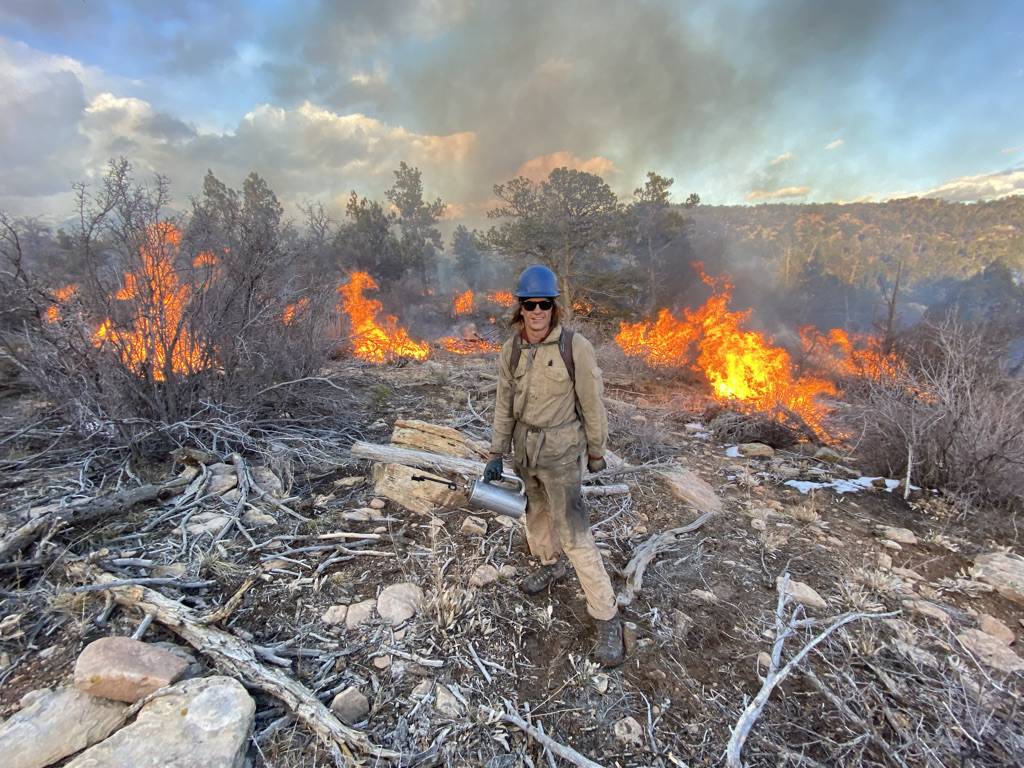J. Bradley Washa, Utah State University Extension assistant professor, wildland fire science, and chair, Utah Prescribed Fire Council
As many parts of Utah transition from an extended fall wildfire season to winter weather, some may wonder why pile burning is becoming more common around the state. Consider this information.
* Most Utah ecosystems are defined as fire-dependent. Without natural and human-originated burning, these forest and rangeland systems are out of balance with nature. Wildland fires have not occurred for up to 150 years in many areas around Utah, resulting in a buildup of fuels. Thus, altering natural fire regimes from their historical ranges is only complicated by invasive species. When wildfires occur today in areas that have not had fire, they are more severe, and more acres are burned. One way to mimic wildland fire is to thin forest and brush vegetation, pile the cut material, and burn the piles. The increase in seeing more pile burning is because of the increased wildfire risk and associated hazards. Luckily, funding opportunities have increased to address this concern.
* Piling and burning can be costly, so areas of high priority must be the focus. Pile burning can be cost-effective compared to other treatment methods, such as removing fuels and/or chipping. Pile burning often occurs in the wildland/urban interface, where people have built homes in forests or the wildlands, where “the leaves meet the eaves.” Pile burning also occurs along many road systems, provides safer ingress and egress during a wildfire, and helps with wildfire management. Pile burning and its associated treatments may be a final phase or an initial treatment, followed by later broadcast or understory burning. While this type of pile burning is common throughout the West and has occurred for years, it is relatively new in parts of Utah.
* Pile burning and other fuel treatments are not without controversy because of wildland fire misinformation from personal opinions portrayed as science, internet sites that support varying causes, or comparisons to fire regimes in other parts of the world.
* One concern about pile burning is the smoke. Another concern is that some feel we should not manage our wildlands at all. Many steps are taken to minimize smoke. Piles allow for more complete combustion, as most of the burning occurs in the flaming phase and thus lowers emission rates. Work occurs with the Utah Division of Air Quality to meet regulatory requirements, such as when the lifting and dispersion of smoke will be optimal. In addition, pile burning typically occurs earlier in the day, so the piles will burn down before the air stabilizes in the evening.
* Although it might sound contradictory, one of the reasons for prescribed fire is to reduce the overall amount of smoke in the atmosphere. The smoke produced from wildfire can be two to 18 times greater than that of a prescribed fire. With wildfire, there is no control over the production and transport of emissions, and fewer strategies are available to minimize smoke. While these short-term exposures from prescribed burning can be inconvenient and irritating, the long-term exposure from wildfire smoke is more concerning, as seen this summer when smoke from wildfires as far away as Canada impacted Utah.
* Understanding and managing wildland fire based on scientific principles in a holistic approach is essential in understanding ecosystem dynamics. As the need is realized and opportunities increase, the pace and scale of fuel treatments will expand, addressing our forest health concerns and threats from wildfire.
* Pile burning throughout Utah is planned for the fall as conditions allow with snow on the ground or enough moisture to limit any fire spread from the pile. It is conducted by federal, state, and local agencies, homeowner associations, private landowners, and companies specializing in forestry and wildland fire management. Various state and local rules may apply. Contact your local county fire warden or fire department for specifics on pile burning in your area.
* Through pile burning, we can effectively address the three parts of the National Cohesive Wildland Fire Management Strategy: 1) Developing fire-wise communities, 2) Creating fire-resilient landscapes, and 3) Providing a safe and effective wildfire suppression response. As communities conduct fuel management and burn piles, they support the fire-wise model. Mimicking a wildfire by thinning, piling, and burning helps ensure that when a wildfire burns through the area, the residual trees will have a better chance of surviving a wildfire and minimizing other disturbances to the landscape, such as erosion.

